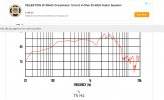Anto
Inspired
Hi to all,
I only use V30's IR, as it's my favorite speaker.
I know the frequency range of a V30's speaker is 50 to 5000 Hz, so, when we use an IR, which is just the speaker cab's tone taken by a mic or mics combination, shouldn't we set the High and Low cuts of the Cab Bloc the same as the frequency range of the speaker we use ?
As we know the mics add lows and highs to the sound of the cab it seems to be logic to cut 50 in the Lows and 5000 in the Highs to be as close as possible to the sound of the V30 cab speaker if we use a V30's IR... Isn't it ? I'm maybe wrong, just want to know for my knowledge.
Thank you.
I only use V30's IR, as it's my favorite speaker.
I know the frequency range of a V30's speaker is 50 to 5000 Hz, so, when we use an IR, which is just the speaker cab's tone taken by a mic or mics combination, shouldn't we set the High and Low cuts of the Cab Bloc the same as the frequency range of the speaker we use ?
As we know the mics add lows and highs to the sound of the cab it seems to be logic to cut 50 in the Lows and 5000 in the Highs to be as close as possible to the sound of the V30 cab speaker if we use a V30's IR... Isn't it ? I'm maybe wrong, just want to know for my knowledge.
Thank you.




